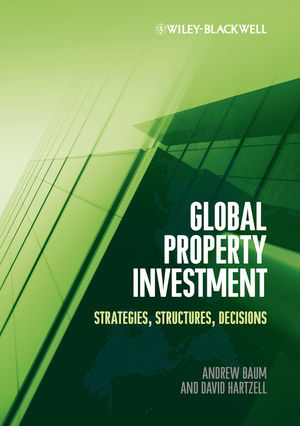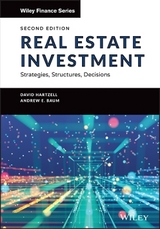
Global Property Investment
Wiley-Blackwell (an imprint of John Wiley & Sons Ltd) (Verlag)
978-1-4443-3528-6 (ISBN)
- Titel erscheint in neuer Auflage
- Artikel merken
Developments in the sophistication of global real estate markets mean that global real estate investment is now being executed professionally. Thanks to academic enquiry, professional analysis and entrepreneurial activity, backed by the globalisation of all investment activity, there is now an available body of material which forms the basis of this scholarly but practical summary of the new state of this art. The measurement, benchmarking, forecasting and quantitative management techniques applied to property investments are now compatible with those used in other asset classes, and advances in property research have at last put the ongoing debate about the role of real estate onto a footing of solid evidence. The truly global scope and authorship of this book is unique, and both authors here are singularly well qualified to summarise the impact and likely future of global innovations in property research and fund management. Between them, they have experienced three real estate crashes, and have observed at first hand the creation of the real estate debt and equity instruments that led to the global crisis of 2008-9.
Global Property Investment: strategies, structure, decisions offers a unique perspective of the international real estate investment industry with: * a close focus on solutions to real life investment problems * no excessive theoretical padding * a target of both students and professionals * highly qualified dual-nationality authorship With many cases, problems and solutions presented throughout the book, and a companion website used for deeper analysis and slides presentations (see below), this is a key text for higher-level real estate students on BSc, MSc, MPhil and MBA courses worldwide as well as for practising property professionals worldwide in fund management, investment and asset management, banking and real estate advisory firms.
Andrew Baum was appointed Professor of Land Management at the University of Reading, UK in 1989. He is now Professor of Real Estate Investment at the University of Cambridge and a Fellow of St John's College, Cambridge. He is former Head of Research, Prudential; CIO Property and Head, International Property, Henderson Global Investors, and has chaired the investment committee for the CBRE Global Investors Multi-Manager business since 2008. David Hartzell is Steven D. Bell and Leonard W. Wood Distinguished Professor in Real Estate and Professor of Finance at the Kenan-Flagler Business School, University of North Carolina, USA. He is a former vice president at Salomon Brothers Inc. in New York and is now a board member with Highwoods Properties, a REIT.
Preface x Acknowledgements xv PART ONE REAL ESTATE AS AN INVESTMENT: AN INTRODUCTION 1 Chapter 1 Real estate the global asset 3 1.1 The global property investment universe 3 1.2 Market players 6 1.3 Property its character as an asset class 11 1.4 Conclusions 28 Chapter 2 Global property markets and real estate cycles 32 2.1 Introduction 32 2.2 The United States 34 2.3 The UK property market a performance history 67 2.4 Continental Europe 80 2.5 Asia 83 2.6 Conclusions 91 Chapter 3 Market fundamentals and rent 94 3.1 Introduction: the global property cycle 94 3.2 The economics of rent 95 3.3 Forecasting rents 109 3.4 Conclusions 116 Chapter 4 Asset pricing, portfolio theory and real estate 117 4.1 Risk, return and portfolio theory 117 4.2 A property appraisal model 124 4.3 The model components 132 4.4 The required return for property assets 140 4.5 Forecasting real estate returns 142 4.6 Conclusions: a simple way to think about real estate returns 151 PART TWO MAKING INVESTMENT DECISIONS AT THE PROPERTY LEVEL 155 Chapter 5 Basic valuation and investment analysis 157 5.1 Introduction 157 5.2 Estimating future cash flows 161 5.3 The discount rate 166 5.4 Conclusions 170 Chapter 6 Leasing 171 6.1 Introduction 171 6.2 Legal characteristics of leases 173 6.3 The leasing process 174 6.4 Important economic elements of a lease 174 6.5 Lease economics and effective rent 192 6.6 Conclusions 199 Chapter 7 Valuing commercial real estate: the unleveraged case 203 7.1 Introduction: the investment opportunity 203 7.2 Developing a pro-forma income statement 206 7.3 Valuation using the cap rate 210 7.4 Valuation using cash flows 212 7.5 Applying discounted cash flow to analyze investment feasibility 219 7.6 Conclusions 221 Chapter 8 Mortgages: an introduction 222 8.1 Introduction 222 8.2 What is a mortgage? 223 8.3 The risks and returns of mortgage investment 225 8.4 The fi nancial components of a mortgage 226 8.5 The mortgage menu 229 8.6 An introduction to mortgage mathematics 231 8.7 Conclusions 247 Chapter 9 Commercial mortgage underwriting and leveraged feasibility analysis 248 9.1 Introduction 248 9.2 The mortgage underwriting process 248 9.3 Investment feasibility with leverage: before-tax analysis 256 9.4 Investment feasibility with leverage: after-tax analysis 263 9.5 Global variations in real estate debt 270 9.6 Conclusions 272 Chapter 10 Valuing the private real estate entity 274 10.1 Introduction: the four quadrants and private equity 274 10.2 Sponsor economics 276 10.3 The life cycle of a private equity fund 277 10.4 Fund economics 279 10.5 Waterfall structures 282 10.6 Private equity structures in the credit crisis 289 10.7 Conclusions 291 PART THREE REAL ESTATE INVESTMENT STRUCTURES 293 Chapter 11 Unlisted real estate funds 295 11.1 Introduction to unlisted real estate funds 295 11.2 The growth of the unlisted real estate fund market 299 11.3 Unlisted fund structures 303 11.4 Characteristics of unlisted real estate funds 307 11.5 Liquidity and valuation issues 310 11.6 The case for and against unlisted real estate funds 312 11.7 Conclusions 317 Chapter 12 Public equity real estate 319 12.1 Introduction 319 12.2 REITs and REOCs 320 12.3 Listed funds and mutual funds 321 12.4 Exchange-traded funds (ETFs) 321 12.5 The US REIT experience 322 12.6 The global market 331 12.7 REIT pricing 335 12.8 Conclusions 339 Chapter 13 Real estate debt markets 340 13.1 Introduction 340 13.2 A brief history lesson 342 13.3 Wall Street Act I: the early residential mortgage-backed securities market 344 13.4 Wall Street Act II: senior-subordinated securities, the advent of structured finance 350 13.5 Wall Street Act III: the evolution of structured finance 356 13.6 Collateralized debt obligations (CDOs) 361 13.7 Summary 363 13.8 Mezzanine debt 364 13.9 Cash-out refinancing 367 13.10 All good things must come to an end 369 13.11 Conclusions 377 Chapter 14 Real estate derivatives 378 14.1 Introduction 378 14.2 A short history of the real estate derivatives market 379 14.3 Total return swaps 381 14.4 Structured real estate index notes 386 14.5 Traded property futures and options 387 14.6 Pricing property derivatives 389 14.7 Property derivatives: pros and cons 399 14.8 Property derivatives: spin-offs 401 14.9 Conclusions 405 PART FOUR CREATING A GLOBAL REAL ESTATE STRATEGY 407 Chapter 15 International real estate investment: issues 409 15.1 Introduction: the growth of cross-border real estate capital 409 15.2 The global real estate market 411 15.3 The case for international real estate investment 415 15.4 The problems: an introduction 419 15.5 Technical issues 420 15.6 Formal barriers 423 15.7 Informal barriers 427 15.8 Conclusions 433 Chapter 16 Building the global portfolio 440 16.1 The top-down portfolio construction process 440 16.2 Strengths, weaknesses, constraints: portfolio analysis 447 16.3 A pricing approach for international property 451 16.4 Managing currency exposure and currency risk 463 16.5 Portfolio construction 471 16.6 Conclusions 474 Chapter 17 Performance measurement and attribution 475 17.1 Performance measurement: an introduction 475 17.2 Return measures 476 17.3 Attribution analysis: sources of return 487 17.4 Attribution analysis: the property level 489 17.5 Attribution analysis: the portfolio level 492 17.6 Attribution and portfolio management: alpha and beta 502 17.7 Performance measurement and return attribution for property funds 505 17.8 Conclusions 518 Chapter 18 Conclusions 520 18.1 Why property? 520 18.2 Liquid structures 521 18.3 Unlisted funds 521 18.4 International investment 523 18.5 Best-practice real estate investment 523 18.6 Pricing 524 18.7 The future 525 References 526 Glossary 533 Index 548
| Erscheint lt. Verlag | 30.12.2011 |
|---|---|
| Verlagsort | Chicester |
| Sprache | englisch |
| Maße | 172 x 247 mm |
| Gewicht | 1092 g |
| Themenwelt | Wirtschaft ► Betriebswirtschaft / Management ► Finanzierung |
| Wirtschaft ► Betriebswirtschaft / Management ► Rechnungswesen / Bilanzen | |
| Betriebswirtschaft / Management ► Spezielle Betriebswirtschaftslehre ► Immobilienwirtschaft | |
| ISBN-10 | 1-4443-3528-6 / 1444335286 |
| ISBN-13 | 978-1-4443-3528-6 / 9781444335286 |
| Zustand | Neuware |
| Haben Sie eine Frage zum Produkt? |
aus dem Bereich



